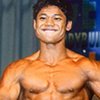Ever since I started weight training, I have always read that in order to stimulate the most muscle growth one should go heavy. Well, I've learned that after three years of training, one should cycle heavy training cycles with lighter training cycles to achieve optimum results.
Simply put, big strong muscles are the result of lifting big heavy weights. They are not, however, the result of lifting heavy weights only. Light training has an important place in building a great body. You need to learn to balance the two to develop the best possible physique.
Bodybuilding is an art as much it is a science. Although the principles are the same for everyone, each individual has to learn how to use them. The art of building your body demands that you get to know yourself. You must learn exactly what the body requires in order to grow. Basically, you are the master of your own destiny.
Find The Balance ///
The big question is, how much heavy training and how much light training does one really need? Heavy training is like extremely powerful medicine. The right amount will work wonders, but too much will be counterproductive. The right amount of heavy training taxes the muscles to the limit, just often enough. My experience indicates that one extremely heavy total-body workout a week is the right amount.
I know that a lot of champion pro bodybuilders advise training more frequently, but you have to understand how much "stuff" they're taking. This approach should produce great results for the vast majority of trainees. Even if you train on a split routine, I strongly urge that you should not work any muscle group to its maximum more than once per week.
Light workouts may feel as if you're coasting but they're just as important as heavy training. They speed muscular recovery by improving circulation and keeping the muscle fibers activated without breaking them down intensively. One light workout a week, normally following the heavy workout, is most effective for most people.
There's always the temptation to push a little more than you should on your light day, however. If your program is going as it should, you'll feel strong and energetic and you'll want to go heavier. Don't do it! Don't deplete that extra energy and strength. Let it build up, and then, on your heavy day, really go for it.
Extreme "hardgainers" will probably do best with just two workouts a week, but most people profit from three workouts--heavy, light and medium, in that order. On a heavy day, you should train at no less than 95 percent of your capacity on every part of your routine. A light day should demand about 60 percent. A medium day calls for about 75 percent--a hard workout but not a maximum one.
Common Problems ///
Too Much: They find that the heavy/light/medium schedule seems to be too much. After several weeks they're really pushing on their heavy days and have no energy for their other workouts.
Not Enough: They find that the program isn't taxing enough. They recover quickly and think they're wasting their time.
Remedies ///
The remedies should be obvious. Give the schedule a six-week trial. If you find it's too much, drop back to two workouts a week. See how a heavy and a light workout feel. If that doesn't seem to be quite enough, try a heavy and two light workouts, or a heavy and a medium session. Whatever you do, don't do two heavy sessions back to back.
On the other hand, if you think you aren't getting enough work, put more effort into your heavy and medium workouts. Do not increase the light workout. You need that light day for reasons I have previously mentioned.
Some people I know, including myself, have made incredible strength gains with just one workout a week. That's not, however, enough physical training for fitness, conditioning or health building. If you're involved in another athletic activity, one heavy weight session a week might be perfect. Just make sure you warm up thoroughly first.
Conclusion
Developing an admirable physique is not a one-method-fits-all project. Each individual requires a unique approach, one tailored to his/her needs. Learn to balance workouts that demand enormous effort and workouts that tone and maintain condition. That's the path to a lifetime of great training and the realization of your own genetic potential. Until next time, train hard, train smart, think BIG!
